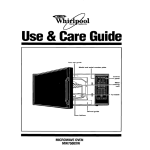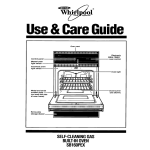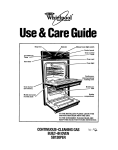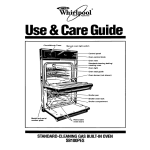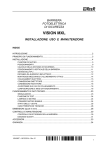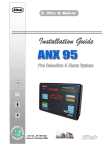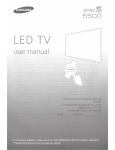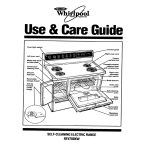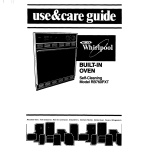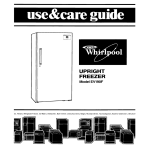Download Whirlpool RB770PXX Specifications
Transcript
Use& CareGuide Control panel Oven vent Lock lever cover panel -Oven lock latch -oven Self-clean (single/ wper) Broiler element Oven rack guides Bake element Fiberglass heat seal Removable oven door SELF-CLEANING ELECTRIC BUILT-INSINGLEANDDOUBLEOVENS RB760PX.XRB770PXXFIB1GOPXXRB17OPX.X Contents Thank you for buying a Whirlpool appliance. Page Please complete and mail the Owner RegistraImportant Safety Instructions _._._._.__._......._...... 3 Using Your Oven .._..._._..._...... 4 tion Card provided with this product. Then The electronic MEALTIMER “clock .__._._._..........5 complete the form below. Have this information ready if you need service or call with a question. Using the oven controls __.___,,_,_,_,_._..__.._._._......_. 8 Using the electronic l Copy model and serial numbers from plate MEALTIMER’” clock ,.,.,..,.,,,.,,,,.,_,.,.,,,,,..,_,_ 18 (located on the lower left side of the door opening Other operating hints .,.,.,.,.,,, ,_,.,,., ,,.,_,_,_,____,_._ 21 on the single/upper oven) and purchase date The oven vent ._._.____,_,_,_,_,______.___.____._,_,_,_,_,_,,_ 21 from sales slip. Caring For Your Oven ,.,_,.,,,,_,_,_,,_,_,_,_,_.,,_,__._._ 22 l Keep this book and the sales slip together in a Control panel and knobs ________.__. .__._._._._,__,___._ 22 handy place. Standard oven cleaning ,.,_,_,_,,_,_,_,_,___,__._._._.___ 22 Using the Self-Cleaning cycle ._,_,_,_,_..,._._.___._._ 23 Model Number Cleaning tips ._._.__._.___._.______._.__..__._._._._.._..._._._ 28 Removable oven door(s) __._._...._..._._.... .._29 The oven lights ._._,_,_.,.,,..,_,_,,,,.,_,_,_,.,,_..,_,___,_,_ 30 Serial Number If You Need Service Or Assistance _._._,__._, _, ,3 1 Purchase Date Whirlpool Oven Warranty .._._......................... 32 01990 Whirlpool Corporation Remove the Consumer Buy Guide label. It will be easier to remove before the oven is used. To remove any remaining glue: l Rub briskly with thumb to make a ball, then remove. or l Soak area with liquid hand dishwashing detergent before removing glue as described above. Do not use sharp instruments, rubbing alcohol, flammable fluids or abrasive cleaners. These can damage the finish. See “Important Safety Instructions” on page 3. Service Company Phone Number You are responsible for: Installing the oven where it is protected from the elements, and in a wall or cabinet strong enough to support its weight. (See the Installation Instructions.) l Making sure the oven is not used by anyone unable to operate it properly. l Properly maintaining the oven. l Using the oven only for jobs expected of a home oven. l ImportantSafetyInstructions To reduce the risk of fire, electrical shock, injury to persons, or damage when using the oven, follow basic precautions, including the following: Read all instructions before using the oven. . Install or locate the oven only in accordance with the provided Installation Instructions. It is recommended that the oven be installed by a qualified installer. The oven must be properly connected to electrical supply and grounded. l Do not operate the oven if it is not working properly, or if it has been damaged. l Do not use the oven for warming or heating the room. Persons could be burned or injured, or a fire could start. l Use the oven only for its intended use as described in this manual. l Do not wear loose or hanging garments when using the oven. They could ignite if they touch a heating element and you could be burned. l Do not touch heating elements or interior surfaces of oven. Heating elements may be hot even though they are dark in color. Interior surfaces of an oven become hot enough to cause burns. During and after use, do not touch, or let clothing or other flammable materials contact heating elements or interior surfaces of oven until they have had sufficient time to cool. Other surfaces of the oven may become hot enough to cause burns; such as, the oven vent opening, the surface near the vent opening, the oven door and the oven door window. ’ Use only dry potholders. Moist or damp potholders on hot surfaces may result in burns from steam. Do not let potholder touch hot heating elements. Do not use a towel or bulky cloth for a potholder. They could catch on fire. B DO not heat unopened containers. They could explode. The hot contents could cause burns and container particles could cause injury. ’ Grease is flammable and should be handled carefully. Let fat cool before attempting to handle it. Wipe spill-overs immediately. l . Do not use water on grease fires. Never pick up a flaming pan. Smother flaming pan by covering with a well-fitted lid, cookie sheet or flat tray. Flaming grease outside of pan can be extinguished with baking soda or, if available, a multipurpose dry chemical or foam-type extinguisher. 9 Use care when opening oven door. Let hot air or steam escape before removing or replacing food. l Always position oven racks in desired location while oven is cool. If rack must be moved while oven is hot, do not let potholder contact hot heating element in oven. . Do not store flammable materials in or near the oven. They could explode or burn. l Do not store things children might want above the oven. Children could be burned or injured while climbing on it. l Do not leave children alone or unattended in area where the oven is in use. They should never be allowed to sit or stand on any part of the oven. They could be burned or injured. l Keep oven vents unobstructed. l Clean your oven regularly. See care and cleaning instructions in this manual. . Be sure all oven parts are cool before cleaning. l Do not clean door seal. It is essential for a good seal. Care should be taken not to rub, damage, or move the seal. Clean only parts recommended in this Use and Care Guide. l Do not use oven cleaners on the single/upper oven. No commercial oven cleaner or oven liner protective coating of any kind should be used in or around any part of the oven. . Before self-cleaning the single/upper oven, remove broiler pan, broiler grid, oven racks and other utensils. Do not use your oven to clean miscellaneous parts. l Do not repair or replace any part of the oven unless specifically recommended in this manual. All other servicing should be referred to a qualified technician. l FOR YOUR SAFETY l STORE OR USE GASOLINE OR OTHER FLAMMABLE VAPORS AND LIQUIDS IN THE ‘WINITY OF THIS OR ANY OTHER APPLIANCE. THE FUMES CAN CREATE A FIRE HAZARD OR EXPLOSION. - SAVE THESE INSTRUCTIONS DO NOT 3 UsingYourOven Double oven control panel Minisec button I Bake hours button Electronic clock/ minute timer Stop time button Self-clean button Set knob I Oven light switch Lower oven temperature Upper oven clean indicator Upper oven selector Lower oven heating Upper oven locked indicator light Upper oven heating indicator light Upper oven temperature control Single oven control panel Minlsec button Bake hours button Electronic Stop time button clock Self-clean button Set knob Oven light switch Oven selector Oven heating indicator light Oven locked indicator light Oven clean indicator light Oven temperature control The electronic MEALTIMER’” clock The electronic MEALTIMER”’ clock handles many different types of functions. The following operating hints may be helpful when using the clock: l The numbers on the display change rapidly when turning the Set Knob. . When setting the Time-of-Day clock, the display shows hours and minutes. Twenty-five minutes past six o’clock. Forty-five minutes past twelve o’clock. When using the MiniSec Timer. the display shows minutes and seconds in the sequence shown. - For settings from l-59 seconds, each second will show in the display. l - For settings from l-1 0 minutes, the display will increase in 10 second increments. - For settings from 1O-99 minutes, the display will increase in 1 minute increments l Two hours and fifteen minutes. When using the Bake Hours and/or Stop Time, the display shows hours and minutes. Eleven hours and fifty-nine minutes. Other operating hints may be found on page 21. 5 Using Your Oven Continued Setting the electronic clock 1. Push in both the MiniSec Timer button and the Bake Hours button. “0:OO” will show in the display and the Indicator Lights will go off. 2. Turn the Set Knob to set the right time of day. Turning the knob clockwise increases the numbers, while turning the knob counterclockwise decreases the numbers. The display will show the time you set in hours and minutes. Using the electronic minute timer The Minute Timer does not start or stop the oven. It works like a kitchen timer. It can be set in minutes and seconds up to 99 minutes. You will hear beeps when the set time is up. 1. Push in the MiniSec Timer button. The Indicator Light will come on and the display will show “0:OO”. 2. Turn the Set Knob until the desired time shows in the display. Turning the knob clockwise increases the numbers, while turning the knob counterclockwise decreases the numbers. 3. After setting the time you want, the Indicator Light will stay on and the display will start counting down in seconds. 4. When the time is up, you will hear a beeping sound. Push the MiniSec Timer button to stop the beeping. The beeping will automatically stop after l-2 minutes. Using Your Oven Continued Using the oven controls Single/upper oven controls The single/upper oven can be used for baking, roasting and broiling. The oven has two controls - a Selector and a Temperature Control. Both must be set for the oven to work. casseroles. OFF - Use this setting to turn the oven off. a Lower oven control (for double ovens) The lower oven can be used for baking, roasting and broiling. It is controlled by a single Temperature Control, with settings from 150°F (warm) to BROIL (550°F). Be sure the Temperature Control is turned to OFF when the oven is not in use. NOTE: The lower oven will not operate while the upper oven is being cleaned. No. No. No. No. Rack positions: There are two racks for the single/upper oven. One rack is straight and the other is offset. The offset rack permits intermediate positions for the placement of food within the oven. The lower oven has only one flat rack. Your oven(s) has four rack positions. Rack position 4 is the highest position, or farthest from the bottom of the oven. Rack position 1 is the lowest position, or closest to the bottom of the oven. Be sure to arrange the oven rack(s) before putting foods into the oven or turning the oven on. When baking on two racks, arrange racks on bottom and third level from bottom. To remove oven racks: 1. Pull rack out until bar on back of rack touches first stop. 2. Lift front of rack up until rear position of rack slides out between the two front stops. Preheating the oven For best results when baking, preheat the oven until the Oven HEATING Indicator Light goes out, unless the recipe states otherwise. Set the Selector to BAKE and the Temperature Control to the desired temperature. Use care in turning the Temperature Control so you do not go past the desired set point. If you accidentally go past the desired setting, turn the dial fully counterclockwise and then reset to the desired setting to get an accurate temperature setting. The Oven HEATING Indicator Light will go out when the desired temperature has been reached and will cycle on and off with the elements during the heating period. Be sure the Selector is turned to OFF and the Temperature Control is turned to OFF when the oven is not in use. 9 Using Your Oven Continued Baking/roasting in the single/upper oven: 1. Position the racks properly before turning on the oven. To change rack position, pull rack out to stop, lift at front and remove. The racks should be placed so the top of the food will be centered in the oven. Always leave at least 1 l/2 to 2 inches (4-5 cm) between the sides of the pan and the oven walls and other pans. 4. Put food in the oven. During baking or roasting, the elements will turn on and off to keep the oven temperature at the setting. The Upper Oven HEATING Indicator Light will turn on and off with the elements. The bottom element and outer top element operate at full power and glow red whenever heating. Baking/roasting in the lower oven (for double ovens): 1. Position the rack properly before turning on the oven. To change rack position, pull rack out to stop, lift at front and remove. The rack should be placed so the top of the food will be centered in the oven. Always leave at least 1 l/2 to 2 inches (4-5 cm) between the sides of the pan and the oven walls and other pans. 2. Set the Lower Oven Temperature Control to the temperature you want. (See the “Baking chart” on page 12 or the “Roasting chart” on page 13.) The Lower Oven HEATING Indicator Light will come on. The oven is preheated when the Lower Oven HEATING Indicator Light first goes off. 3. Put food in the oven. During baking or roasting, the elements will turn on and off to keep the oven temperature at the setting. The bottom element and outer top element operate at full power and glow red whenever heating. 4. When baking/roasting is done, turn the Lower Oven Temperature Control to OFF. The Lower Oven HEATING Indicator Light will go OFF. Using Your Oven Continued Baking chart: FOOD OVEN TEMPERATURE APPROXIMATE COOKING TIME Breads, yeast loaf l rolls, oan 375°F 400°F (Min.) 30-40 12-15 Breads, quick biscuits l muffins l popovers l corn bread l nut bread l gingerbread 450°F 400°F 450°F 425°F 350°F 350°F IO-15 20-25 20-25 25-30 60-75 25-30 Cakes angel food . layer cake l loaf cake l sponge cake l pound cake l fruit cake l sheet cake 375°F 35O”F-375°F 350°F 350°F 350°F 300°F 300°F 30-40 20-30 35-45 35-45 35-45 2-2 112 hrs. 25-35 375°F 375°F 375°F 375°F 350°F 350°F 10-15 8-12 IO-15 10-15 20-30 12-15 375°F 300°F 325°F 400°F 50-60 5-6 hrs. 35-40 75 350°F 375°F 325°F 350°F 350°F 45-60 30-40 40-60 60-90 50-60 400°F 350°F 450°F 35-40 30-40 10-12 400°F 400°F 350°F 25-30 40-50 10-15 l l l Cookies drop ’ rolled and refrigerated l chocolate l fruit and molasses l brownies l macaroons l Miscellaneous apples, baked l beans, baked . custard, cup l potatoes, baked l pudding bread cottage rice l scalloped dishes l souffle l Pastries cream puffs l custard and pumpkin pie l pastry shell l two crust fruit pie cooked filling uncooked filling l meringue topping l 12 Roasting chart: - Set selector to Bake. - Roast at oven temperature of 325”F.* - Place roasting pan on flat rack-position MEAT Beef rolled rib . rare l medium l well done APPROXIMATE WEIGHT Preheat not needed 1. APPROXIMATE MINUTES PER POUND MEAT THERMOMETER TEMPERATURE 5-6 Ibs 25-29 35-37 45-47 140°F 160°F 170°F 23-25 30-32 35-40 140°F 160°F 170°F 25-30 35-37 160°F 170°F 18-20 21-24 30-32 140°F 15O”F-155°F 180°F 3-4 Ibs 5-6 Ibs 45-48 28-30 170°F 170°F shoulder 4-5 Ibs 40-44 185°F ham, fully cooked 3-5 Ibs 8-l 0 Ibs 17-18 13-14 130°F 130°F 3-4 Ibs 28-30 185°F” 1O-l 6 Ibs 18-25 Ibs 14-19 11-15 17O”F-180°F 17O”F-180°F 3-4 Ibs 5-6 Ibs 35-38 43-45 170°F 170°F standing rib l rare l medium l well done 6-7 Ibs rump roast medium . well done 4-6 Ibs l Lamb leg l rare l medium l well done Pork loin Poultry chicken* turkey, unstuffed Veal loin shoulder 6-7 Ibs *For chicken, set the oven temperature to 350°F. **The muscles may not be large enough to use a thermometer. 13 Using Your Oven Continued Adjusting the oven temperature controls Does your oven seem hotter or colder than your old oven? The temperature of your old oven may have shifted gradually without you noticing the change. Your new oven is properly adjusted to provide accurate temperatures. But, when compared to your old oven, the new design may give you different results. If, after using the oven for a period of time, you are not satisfied with the temperature settings, they can be adjusted by following these steps: 1. For the oven you want to adjust, pull the Oven Temperature Control Knob straight off. Locking screw 2. Loosen the locking screw. Note the positions of the notches. OFF OFF 3. To lower the temperature, move the tooth a notch closer to LO. Each notch equals about 10°F (5°C). J To Tooth 14 To raise ’ \ Notches 4. To raise the temperature, move the tooth a notch closer to HI. Each notch equals about 10°F (5°C). Tighten the locking screw and replace the control knob. Broiling in the single/upper oven: Broiling is a quick-cook method that will produce foods that are brown on the outside and moist and juicy on the inside. 1. Position the racks properly before turning on the oven. To change rack position, pull rack out to stop, lift at front and remove. Place food on grid on broiler pan and place in center of the oven rack. Turn the pan so that the long side is parallel to the oven door for the best heat distribution and air flow. 3. Close the door to the Broil Stop position (open about 6 inches, 15.2 cm). The door will stay open by itself. Door can remain closed during broiling, however results may differ. Set the Upper Oven Selector to BROIL. Do not preheat the broiler. Set the Upper Oven Temperature Control to BROIL or, for custom broiling, to the broiling temperature you want. (See the “Broiling chart” on page 17.) The Upper Oven HEATING Indicator Light will come on. When broiling is done, turn both the Upper Oven Selector and the Upper Oven Temperature Control to OFF. The Upper Oven HEATING Indicator Light will go OFF. 15 Using Your Oven Continued Broiling in the lower oven (for double ovens): 1. Position the rack properly before turning on the oven. To change rack position, pull rack out to stop, lift at front and remove. 2. Place food on grid on broiler pan and place in center of the oven rack. 3. Close the door to the Broil Stop position (open about 6 inches, 15.2 cm). The door will stay open by itself. Door can remain closed during broiling, however results may differ. 16 Broiling chart: The recommended rack position is numbered lowest (1) to highest (4) FLAT RACK POSITION SELECTOR TEMPERATURE Steak, 1” thick l rare l medium l well done 3 BROIL 550°F Steak, 1 112” thick 9 rare l medium 3 MEAT Hamburger 112” thick l medium APPROXIMATE TOTAL TIME (MINUTES) 16 21 25 BROIL 550°F 23 28 patties, 4 BROIL 550°F 8-l 2 3 BROIL 400°F 18-20 Ham slice 112” thick 1” thick 3 BROIL 550°F 10-12 20-22 Pork chops, 3 BROIL 450°F 25-28 Frankfurters 3 BROIL 550°F 8 Chicken 2 BROIL 550°F 32 Fish 112” thick 1” thick 2 2 BROIL BROIL 350°F 20 20-22 Calves 3 BROIL 350°F IO-12 Lamb chops, 1” thick 1” thick pieces liver, 112” thick Using Your Oven Continued Using the electronic MEALTIMER’”clock The electronic MEALTIMER’” clock is designed to turn the upper oven on and off at times you set, even if you are not around. Automatic baking is ideal for foods which do not require a preheated oven, such as meats and casseroles. Do not use the automatic cycle for cakes, cookies, etc...undercooking will result. To start baking now and stop automatically: 1. Position the oven racks properly and place the food in the upper oven. 2. Make sure the clock is set to the right time of day. (See “Setting the electronic clock” on we 6.1 3. Set the Upper Oven Selector to TIMED BAKE. 4. Set the Upper Oven Temperature baking temperature you want. 18 Control to the 5. Set the clock for the length of baking time you want. Push in the Bake Hours button. Turn the Set Knob until the length of baking time you want shows in the display. This example shows 2 hours, 15 minutes. Bake Hours can be set for up to 11 hours, 59 minutes. 6. The BAKE HOURS Indicator Light will stay on and the STOP TIME Indicator Light will flash. The Auto Oven Symbol (in upper left corner of display) and HEATING Indicator Light will come on. The display will count down in minutes. If you want to see Stop Time, push the Stop Time button. Push the Bake Hours button to see baking time again. 7. When the baking time is complete, the oven will beep for l-2 minutes. To stop, push the Bake Hours button. Turn the Upper Oven Selector and Upper Oven Temperature Control to OFF. 8. To stop the timer before the programmed time, push in the Bake Hours button and turn the Set Knob counterclockwise until the display shows “0:OO”. The display will return to the time of day. Turn the Upper Oven Selector and Upper Oven Temperature Control to OFF. To delay start and stop automatically: Position the oven racks properly and place the food in the upper oven. Make sure the clock is set to the right time of day. (See “Setting the electronic clock” on page 6.) Set the Upper Oven Selector to TIMED BAKE. Set the Upper Oven Temperature Control to the baking temperature you want. 19 Using Your Oven Continued 5. Set the clock for the time of day you want the food to be done (Stop Time): Push in the Stop Time button, then turn the Set Knob until the time of day you want the food to be done shows on the display. This example shows 6 o’clock. 6. The display will show the time you want set. The STOP TIME Indicator Light will stay on. The BAKE HOURS Indicator Light will flash. 7. Set the clock for the length of baking time you want: Push in the Bake Hours button, then turn the Set Knob until the length of baking time you want shows in the display. This example shows 2 hours, 15 minutes. Bake Hours can be set for up to 11 hours, 59 minutes. 8. The BAKE HOURS Indicator Light will stay on and the STOP TIME Indicator Light will flash. If you want to see the Stop Time, push the Stop Time button. Push the Bake Hours button to see baking time again. 9. The clock automatically calculates the time to turn the oven on. At that time, the Auto Oven Symbol (in upper left corner of display) and the Upper Oven HEATING Indicator Light will come on and the oven will heat. This example shows the oven on at 45 minutes past 3 o’clock. 20 11. To stop the upper oven before the preset time: Push in the Bake Hours button and turn the Set Knob counterclockwise until the display shows “0:OO”. Turn the Upper Oven Selector and Upper Oven Temperature Control to OFF. To avoid sickness and food waste when using the MEALTIMER”’ clock: . Do not use foods that will spoil while waiting for cooking to start, such as dishes with milk or eggs, cream soups, and cooked meats or fish. Any food that has to wait for cooking to start should be very cold or frozen before it is put in the oven. MOST UNFROZEN FOODS SHOULD NEVER STAND MORE THAN TWO HOURS BEFORE COOKING STARTS. l Do not use foods containing baking powder or yeast when using delay start. They will not rise properly. l Do not allow food to remain in oven for more than two hours after end of cooking cvcle. Other operating hints l l l Oven vent If you want to check what you have programmed, press the button for the function you want to check. The display will show what you have programmed for that function. If you want to check the time of day, press the Min/Sec Timer and Bake Hours buttons. The display will show the time of day. A rapidly flashing Indicator Light indicates an error in programming. Cancel any entries and begin again. The oven vent Hot air and moisture escape from the ovens through vents. The upper oven vent is on the top of the control panel. The lower oven vent is just above the lower oven door. These vents are needed for air circulation. Do not block the vents. Poor baking can result. 21 CaringForYourOven Several finishes have been used on this oven. To prevent damage to these finishes, follow the suggested cleaning method(s) for that finish. NOTE: Some finishes can be damaged from harsh and abrasive cleaning agents. Burn and Electrical Shock Hazard Make sure all controls are OFF and the oven is COOL before cleaning. Failure to do so can result in burns or electrical shock. Control panel and knobs 1. Pull control knobs straight off. 2. Use warm soapy water and a soft cloth, or spray glass cleaner, to wipe the control panel. Rinse and wipe dry. 3. Wash control knobs in warm soapy water. Rinse well and dry. Do not soak. 4. Push control knobs straight back on. Make sure they point to OFF. Standard oven cleaning The standard oven has to be hand cleaned. Use warm soapy water, soapy steel wool pads or a commercial oven cleaner. See “Cleaning tips” on page 28 for further instructions. Do not allow commercial oven cleaner to contact the heating elements, thermostat bulb, heat seal or exterior surfaces of the oven. Damage will occur. Using foil To catch sugar or starchy spills from pies and casseroles, use a piece of heavy-duty aluminum foil or a shallow pan on rack under cooking container, slightly larger than the container. This may, however, result in poor baking. NOTE: Do not use foil or foil liner to cover the oven floor. Poor baking results could occur. 22 Using the Self-Cleaning cycle (single/upper oven) The Self-Cleaning cycle uses very high heat to burn away soil. Before you start, make sure you understand exactly how to use the Self-Cleaning cycle safely. NOTE: The lower oven will not operate while the upper oven is being cleaned. Before you start the areas shown by hand. They do not get hot enough during the Self-Cleaning cycle for soil to burn away. Use hot water and detergent or a soapy steel wool pad on... l The inside of the door. (The center area of the door does not need to be hand cleaned.) l The frame around the oven. Do not clean, move or bend the fiberglass seal. Poor cleaning and poor baking will result. 2. Remove the broiler pan and any pots and pans you may have stored in the oven. NOTE: The broiler pan (without grid) can be cleaned in the oven only if most of the soil has been removed by hand-cleaning or a dishwasher. The chrome broiler grid will discolor if cleaned in the Self-Cleaning cycle. 3. Wipe out any loose soil or grease. This will help reduce smoke during the Self-Cleaning cycle. NOTE: The bottom element is hinged for easier cleaning of the cavity floor. It must be in the down position before beginning the Self-Cleaning cycle. 4. If you want the oven racks to remain shiny, remove from the oven and clean them by hand. Otherwise, put oven racks on second and fourth guides (guides are counted from bottom to top). After racks are cleaned in the SelfCleaning cycle, they become harder to slide. See page 28. NOTE: The smoke eliminator will handle the normal flow of odors during the Self-Cleaning cycle. However, minor smoke may be noticed when soil build-up is heavy. Also, some smoke may appear during the very first Self-Cleaning cycle due to burn-off of binders in oven insulation. To help remove additional smoke, heat and odors turn on a vent hood or other kitchen vent during the Self-Cleaning cycle. 1. Clean land clean frame Hand clean door around edge Do noi hand clean seal 23 Caring For Your Oven Continued Personal Injury and Product Damage Hazard Do not touch the oven during the SelfCleaning cycle. It could burn you. l Do not use commercial oven cleaners in your oven. Cleaners may produce hazardous fumes or damage the porcelain finish. l Do not force the Lock Lever, you could bend or break it. The lever is designed to stay locked until the oven is cool enough to safely open. Wait until it moves freely. . Do not use foil or other liners in the oven. During the Self-Cleaning cycle foil can burn or melt and damage the oven surface. l Do not block the vent during the SelfCleaning cycle. Air must move freely for best cleaning results. l Setting the controls 1. Make sure the clock is set to the right time of day. (See “Setting the electronic clock” on page 6.1 2. Set the Upper Oven Selector and Upper Oven Temperature Control to CLEAN. 24 3. Lift the panel between the oven door and the control panel. Move the Lock Lever all the way to the right - the Clean position. 4. Push in and release the Self-Clean button. A 3-hour Self-Cleaning cycle will be set automatically. The display will count down the time in minutes. The CLEAN and HEATING Indicator Lights will come on. The Auto Oven Symbol (in upper left corner of display) and the SELF-CLEAN Indicator Light on the display will also come on. The display will count down in minutes. If a cleaning cycle other than 3 hours is desired, push in and hold the Bake Hours button and turn the Set Knob to the new time up to 4 hours. l Use 2 hours for light soil. l Use 3 hours for moderate soil. l Use 34 hours for heavy soil. NOTE: The STOP TIME Indicator Light will flash during the entire Self-Cleaning cycle. The BAKE HOURS Indicator Light will stay on. 6. After the Self-Cleaning cycle is completed, the CLEAN and HEATING Indicator Lights will go off. The Auto Oven Symbol and SELFCLEAN Indicator Light on the display will also go off. The display will show the time of day. When the oven reaches normal baking temperatures, the LOCKED Indicator Light goes off. Move the Lock Lever back to the left. Do not I I. a., ,. .., ,. .,I ., rorce II. vvarr unrll It w11imove easily. 25 Caring For Your Oven Continued 8. After the oven is cool, wipe off any residue or ash with a damp cloth. If needed, touch up spots with a soapy steel wool pad. Special tips Keep the kitchen well ventilated during the SelfCleaning cycle to help get rid of heat, odors and smoke. l Clean the oven before it gets heavily soiled. Cleaning a very soiled oven takes longer and results in more smoke than usual. l If the Self-Cleaning cycle doesn’t get the upper oven as clean as you expected, the cycle may not have been set long enough or you may not have prepared the oven properly. Set the SelfCleaning cycle longer the next time and hand clean areas noted on page 23. l To stop the Self-Cleaning cycle at any time: 1. Push in and release the Self-Clean button. 2. Turn the Upper Oven Selector and Upper Oven Temperature Control to OFF. When the LOCKED Indicator Light goes off, move the Lock Lever back to the left. Do not force it. Wait until it moves easily. 26 How it works During the Self-Cleaning cycle, the oven gets much hotter than it does for baking or broiling...approximately 875°F (468°C). This heat breaks up grease and soil and burns it off. This graph shows approximate temperatures and times during a Self-Cleaning cycle for 3 hours. Self-Cleaning cycle -three hour setting (Approximate temperatures and times) 1000°F 800°F 427°C 600°F 316°C 400°F 204°C 200°F START l/2 hr. 1 hr. 1 112 hrs. 2 hrs. 2 112 hrs. 3 hrs. 3 112 hrs. STOP Notice that the heating stops when the 3-hour setting is up, but that it takes longer for the oven to cool down enough to unlock. Caring For Your Oven Continued Cleaning tips Control knobs Clean with warm soapy water and a soft cloth l Wash, rinse and dry well. . Do not soak. Control panel Clean with warm soapy water or spray glass cleaner and a soft cloth. l Wash, rinse and dry well. l Follow directions provided with the cleaner. Porcelain surfaces Clean with warm, soapy water and a soft cloth. l Wipe off regularly when oven is cool. Use a non-abrasive plastic scrubbing pad for heavily-soiled areas. l Do not use abrasive or harsh cleansers. NOTE: Do not allow food containing acids (such as vinegar, tomato, lemon juice or milk) to remain on surface. Acids may remove the glossy finish. Chrome surfaces and trim Clean with warm, soapy water and a soft cloth. l Wash, rinse and dry well. Use mild glass cleaner to remove fingermarks. For heavily-soiled areas, clean with an ammonia solution of 1 cup ammonia to 2 gallons of water. Broiler pan and grid Clean with warm, soapy water or a soapy steel wool pad. l Clean after each use. l Wash, rinse and dry well. l After pan and grid are cool, wipe with a warm, damp cloth. For heavily-soiled areas, use a soapy steel wool scrubbing pad. l Do not clean in Self-Cleaning Oven. (See note on page 23.) Oven racks Use Self-Cleaning cycle (single/upper oven). l Leave in oven during the Self-Cleaning cycle. OR Clean with warm soapy water or soapy steel wool pads. l Wash, rinse and dry. Use soapy steel wool pads for heavily-soiled areas. NOTE: The oven racks will discolor and be harder to slide when left in the oven during the SelfCleaning cycle. If you want them to stay shiny, remove from the oven and clean by hand. If racks are left in the oven during the Self-Cleaning cycle, apply a small amount of vegetable oil to the sides of the racks to make them easier to slide. 28 Oven door glass Use spray glass cleaner or warm soapy water and a non-abrasive plastic scrubbing pad. l Make sure oven is cool . Follow directions provided with the cleaner. l Wash, rinse and dry well. Standard oven (lower oven) Clean with warm, soapy water and a cloth or sponge. l Remove door for easier access. (See page 29.) l Wash, rinse and dry well. Use soapy steel wool pads for heavily-soiled areas. l Remove door for easier access. l Rinse well with water. OR Use commercial oven cleaner for heavily-soiled areas. . Remove door for easier access. l Place newspaper on floor to protect floor surface. l Follow directions provided with the oven cleaner. l Rinse with clear water. l Use in well-ventilated room. l Do not allow commercial oven cleaners to contact the heating elements, heat seal, thermostat bulb or exterior surfaces of the oven. Damage will occur. Use heavy-duty aluminum foil or shallow pan while cooking. . Place piece of foil or shallow pan, slightly larger than the cooking container, on rack under container to catch spill-overs. Self-Cleaning oven (single/upper oven) For areas outside the Self-Cleaning area use warm soapy water or soapy steel wool pads. 9 Follow directions starting on page 23, “Using the Self-Cleaning cycle.” l Dp not use commercial oven cleaners l Do not use foil to line the bottom of your SelfCleaning Oven. l Do not remove Self-Cleaning Oven door except to change oven door front. (See page 29.) Removable oven door(s) The oven door(s) can be removed to change optional oven door front(s) (if available). NOTE: It is recommended not to remove the SelfCleaning Oven door (single/upper) unless you are changing the optional oven door front. The lower oven door (standard clean oven) can be removed for cleaning. See ‘Cleaning tips” on page 28. Personal Injury Hazard . Oven doors are heavy. Use both hands to remove the oven doors. l Grasp only the sides of the oven door. Do not use any portion of the front frame or trim for lifting. Failure to properly grasp the oven door could result in personal injury or product damage. Screw To remove: 1. Open the door completely. 2. Remove the two screws just above the oven door hinges. 3. Close door to the Broil Stop position (door will be open about 6 inches). 4. Hold the door firmly on both sides and lift the door up and out of the hinge slots to remove. Set the door aside. To replace: 1. Grasp door firmly on both sides. Slide the hinge slot in the bottom of the door over the hinges. Push the door down and in to replace. 2. Open the door slightly past the Broil Stop position and push it down to make sure the door is completely installed. 3. Open the door completely. Replace the two oven door screws. 4. Close and open the door slowly to make sure it is replaced properly. NOTE: The inside of the Single/Upper Oven door has a slot for the Oven Lock Lever. Do not replace the Lower Oven door on the Upper Oven cavity, or damage to the interior finrsh may result from the Lock Lever hitting the door surface. 29 Caring For Your Oven Continued The oven lights When you open an oven door, its Oven Light will come on. To turn the light on when the oven door is closed, push the Oven Light Switch on the control panel. Push the switch again to turn off the light, Electrical Shock and Personal Injury Hazard Make sure oven and light bulb are cool and power to the oven has been turned OFF before replacing the light bulb. Failure to do so could result in electrical shock or burns. l The lens must be in place when using the oven. The lens protects the bulb from , breaking, and from high oven temperatures. Broken glass could cause injury. l -a=- 30 Q a To replace the oven light: 1. Unplug appliance or disconnect at the main power supply. 2. Remove the three screws in the lens holder with a Phillips screwdriver. Care should be taken to prevent the holder and the lens from falling into the oven cavity. 3. Lift holder and glass lens out. 4. Remove and replace the light bulb with a 40-watt appliance bulb. 5. Replace the lens and the holder, and tighten the three screws. 6. Plug in appliance or reconnect at the main power supply. If YouNeedServiceOrAssistance. n n We suggest you follow these steps: 1. Before calling for assistance... Performance problems often result from little things you can find and fix without tools of any kind. If nothing operates: Is the power supply cord connected to a live circuit with the proper voltage? (See Installation Instructions.) l Have you checked your home’s main fuses or circuit breaker box? If the oven will not operate: l Is the Selector (upper/single oven) turned to BAKE or BROIL? If Selector is turned to TIMED BAKE, wait until the start time is reached. l Is the Temperature Control turned to a temperature setting? l Is the electronic MEALTIMER-‘ clock set correctly? l Is the Oven Lock Lever all the way to the left? Please include a daytime phone number in your correspondence. 3. If you need service*... Whirlpool has a nationwide if1 ,$.I., ~~p6~o(E!~~~~~d l If the Self-Cleaning cycle will not operate: Are the Selector and Temperature Control set to CLEAN? 9 Does the clock show the right time of day? l Have you set a delay start time? l Did you push the Self-Clean button? 9 Is the Oven Lock Lever all the way to the right? l If cooking results aren’t what you expected: Is the oven level? l Does the oven temperature seem too low or too high? See page 14. l If needed, have you preheated the oven as the recipe calls for? l Are you following a tested recipe from a reliable source? 9 If baking, have you allowed 1 112 to 2 inches (45 cm) on all sides of the pans for air circulation? l Are the pans the size called for in the recipe? l 2. If you need assistance*... Call Whirlpool COOL-LINE” service assistance telephone number. Dial free from anywhere in the U.S.: 1-800-253-l 301 and talk with one of our trained consultants. The consultant can instruct you in how to obtain satisfactory operation from your appliance or, if service is necessary, recommend a qualified service company in your area. If you prefer, write to: Mr. Donald Skinner Director of Consumer Relations Whirlpool Corporation 2000 M-63 Benton Harbor, Ml 49022 companies. Whirlpool service technicians are trained to fulfill the product warranty and provide after-warranty service, anywhere in the United States. To locate the authorized Whirlpool service company in your area, call our COOL-LINE” service assistance telephone number (see Step 2) or look in your telephone directory Yellow Pages under: w ELECTRICAL APPLIANCES MAJOR - REPAIRING & PARTS APPLIANCES. HOUSEHOLD. MAJOR-SERVICE 8 REPAIR OR WASHING MACHINES, DRYERS & IRONERS-SERVICING WHIRLPOOL APPLIANCES AUTHORIZED WHIRLPOOL SERVICE SERVICE COMPANIES XYZ SERVICE CO 123 Mxle... 999~9999 4. If you need FSP. replacement parts*... FSP is a registered trademark of Whirlpool Corporation for quality parts. Look for this symbol of quality whenever you need a replacement part for your Whirlpool appliance. FSP replacement parts will fit right and work right, because they are made to the same exacting specifications used to build every new Whirlpool appliance. To locate FSP replacement parts in your area, refer to Step 3 above or call the Whirlpool COOL-LINE service assistance number in Step 2. 5. If vou are not satisfied with how the problem was solved’... Contact the Major Appliance Consumer Action Panel (MACAP). MACAP is a group of independent consumer experts that voices consumer views at the highest levels of the major appliance industry. Contact MACAP only when the dealer, authorized servicer or Whirlpool have failed to resolve your problem. Major Appliance Consumer Action Panel 20 North Wacker Drive Chicago, IL 60606 MACAP will in turn inform us of your action. When requesting assistance, please provide: model number, serial number, date of purchase, and a complete description of the problem. This information is needed in order to better respond to your request. 31 Whirlpool” RangeProduct Warranty EROOl LENGTH OF WARRANTY WHIRLPOOL FULL ONE-YEAR WARRANTY From Date of Purchase FSP” replacement parts and repair labor to correct defects in materials or workmanship. Service must be provided by an authorized WhirlpoolSM service company. WHIRLPOOL WILL PAY FOR WILL NOT PAY FOR A. Service calls to: 1. Correct the installation of the range product. 2. Instruct you how to use the range product. 3. Replace house fuses or correct house wiring or plumbing. 4. Replace owner accessible light bulbs. B. Repairs when range product is used in other than normal, single-family household use. C. Pick-up and delivery. This product is designed to be repaired in the home. D. Damage to range product caused by accident, misuse, fire, flood, acts of God or use of products not approved by Whirlpool. WHIRLPOOL CORPORATION SHALL NOT BE LIABLE FOR INCIDENTAL OR CONSEQUENTIAL DAMAGES, Some states do not allow the exclusion or limitation of incidental or consequential damages so this limitation or exclusion may not apply to you. This warranty gives you specific legal rights, and you may also have other rights which vary from state to state. Outside the United States, a different warranty may apply. For details, please contact your franchised Whirlpool distributor or military exchange. If you need service, first see the “Service and Assistance” section of this book. After checking “Service and Assistance,” additional help can be found by calling our COOL-LINE” service assistance telephone number, l-800-253-1301, from anywhere in the U.S. 8 Registered Trademark Part No. 3180016 01990 Whirlpool Corporation / TM Trademark / SM Service Mark of Whirlpool Corporation Printed in U.S.A.
































